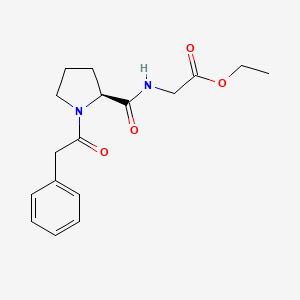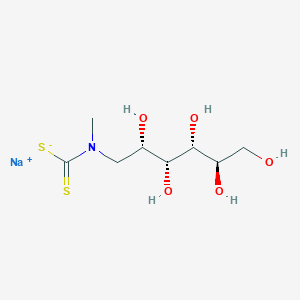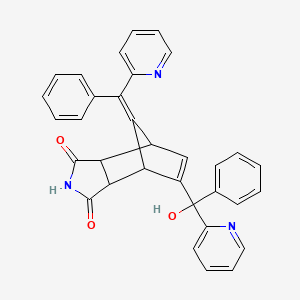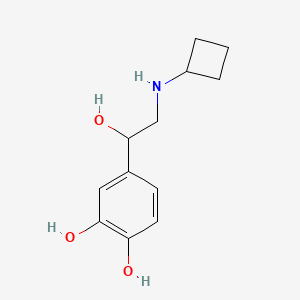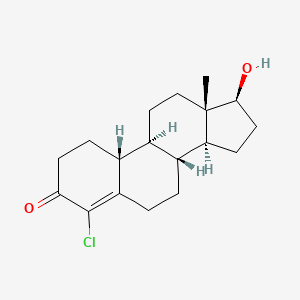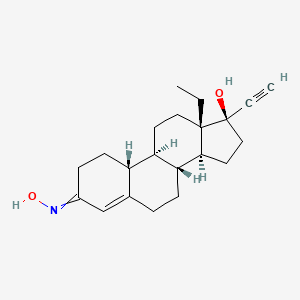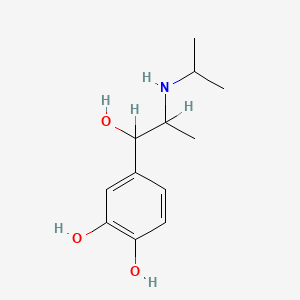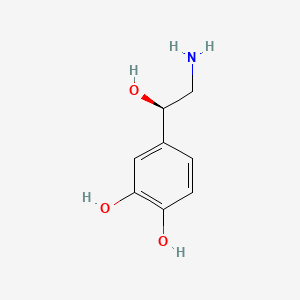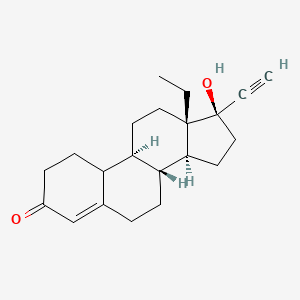
Levonorgestrel
Descripción general
Descripción
Levonorgestrel is a synthetic steroidal progestin used primarily in combination with ethinyl estradiol for oral contraception. It is composed of a racemic mixture of two stereoisomers: dextronorgestrel and this compound. only the levorotary enantiomer (this compound) is biologically active . This compound is also used in menopausal hormone therapy and is available as a generic medication .
Mecanismo De Acción
Target of Action
Norgestrel, specifically its biologically active stereoisomer levonorgestrel, primarily targets the progesterone and estrogen receptors within the female reproductive tract, the mammary gland, the hypothalamus, and the pituitary . These receptors play crucial roles in the regulation of the menstrual cycle and pregnancy.
Mode of Action
Norgestrel binds to the progesterone and estrogen receptors, leading to a series of changes in the reproductive system. Once bound to the receptor, progestins like this compound slow the frequency of release of gonadotropin-releasing hormone (GnRH) from the hypothalamus and blunt the pre-ovulatory luteinizing hormone (LH) surge . This loss of the LH surge inhibits ovulation, thereby preventing pregnancy .
Biochemical Pathways
The binding of norgestrel to progesterone and estrogen receptors affects several biochemical pathways. It suppresses ovulation in approximately half of users, thickens the cervical mucus to inhibit sperm penetration , and triggers changes in the endometrium . Additionally, it has been found to enhance oxidative phosphorylation via the wingless/integrated signaling pathway and trigger reactive oxygen species (ROS) generation .
Pharmacokinetics
Norgestrel is rapidly and completely absorbed, with maximum concentrations reached 1.0 – 2.0 hours after ingestion . The elimination of norgestrel has two phases with half-lives of 0.5 and 20 – 60 hours . These properties influence the bioavailability of norgestrel and its effectiveness as a contraceptive.
Result of Action
The primary result of norgestrel’s action is the prevention of pregnancy. It achieves this by stopping a woman’s egg from fully developing each month . The egg can no longer accept a sperm, and fertilization is prevented . Norgestrel also causes changes in the endometrium and cervical mucus, further preventing the possibility of pregnancy .
Action Environment
The action, efficacy, and stability of norgestrel can be influenced by various environmental factors. For instance, certain drugs can interact with norgestrel and affect its contraceptive efficacy. Drugs such as apalutamide and carbamazepine, which affect hepatic/intestinal enzyme CYP3A4 metabolism, can decrease the serum concentration of norgestrel, potentially leading to contraceptive failure . Therefore, it’s recommended for patients to use an alternative method of contraception or a back-up method during coadministration of these drugs .
Análisis Bioquímico
Biochemical Properties
Norgestrel interacts with various enzymes and proteins in biochemical reactions. It exerts its contraceptive action by several mechanisms: reduction in the sperm penetrability of the cervical mucus and an impairment of luteal function appear important . The serum concentrations of cholesterol and globulin were significantly reduced in women taking norgestrel .
Cellular Effects
Norgestrel has significant effects on various types of cells and cellular processes. It influences cell function, including impact on cell signaling pathways, gene expression, and cellular metabolism .
Molecular Mechanism
Norgestrel exerts its effects at the molecular level, including binding interactions with biomolecules, enzyme inhibition or activation, and changes in gene expression .
Temporal Effects in Laboratory Settings
In laboratory settings, the effects of Norgestrel change over time. This includes information on the product’s stability, degradation, and any long-term effects on cellular function observed in in vitro or in vivo studies .
Dosage Effects in Animal Models
The effects of Norgestrel vary with different dosages in animal models . This includes any threshold effects observed in these studies, as well as any toxic or adverse effects at high doses .
Metabolic Pathways
Norgestrel is involved in various metabolic pathways, including interactions with enzymes or cofactors . This also includes any effects on metabolic flux or metabolite levels .
Transport and Distribution
Norgestrel is transported and distributed within cells and tissues . This includes any transporters or binding proteins that it interacts with, as well as any effects on its localization or accumulation .
Subcellular Localization
This could include any targeting signals or post-translational modifications that direct it to specific compartments or organelles .
Métodos De Preparación
Synthetic Routes and Reaction Conditions
Levonorgestrel is synthesized through a series of chemical reactions starting from steroidal precursors. The synthesis involves multiple steps, including oxidation, reduction, and substitution reactions. The specific details of the synthetic routes and reaction conditions are proprietary to the manufacturers and are not publicly disclosed in detail.
Industrial Production Methods
Industrial production of norgestrel involves large-scale chemical synthesis using advanced techniques to ensure high purity and yield. The process is optimized for cost-effectiveness and efficiency, adhering to stringent quality control measures to meet regulatory standards.
Análisis De Reacciones Químicas
Types of Reactions
Levonorgestrel undergoes various chemical reactions, including:
Oxidation: Conversion of hydroxyl groups to ketones.
Reduction: Reduction of ketones to hydroxyl groups.
Substitution: Replacement of functional groups with other substituents.
Common Reagents and Conditions
Common reagents used in these reactions include:
Oxidizing agents: Such as chromium trioxide and pyridinium chlorochromate.
Reducing agents: Such as lithium aluminum hydride and sodium borohydride.
Substitution reagents: Such as alkyl halides and organometallic compounds.
Major Products
The major products formed from these reactions include various intermediates that are further processed to yield the final norgestrel compound.
Aplicaciones Científicas De Investigación
Levonorgestrel has a wide range of scientific research applications, including:
Chemistry
In chemistry, norgestrel is studied for its synthetic pathways and chemical properties. Researchers explore new methods for its synthesis and modification to improve its efficacy and reduce side effects.
Biology
In biology, norgestrel is used to study hormone regulation and reproductive biology. It serves as a model compound to understand the effects of progestins on cellular processes.
Medicine
In medicine, norgestrel is extensively used in contraceptive pills and hormone replacement therapy. It is also being investigated for its potential neuroprotective effects in retinal diseases .
Industry
In the pharmaceutical industry, norgestrel is a key ingredient in various contraceptive formulations. Its production and quality control are critical for ensuring the safety and efficacy of these products.
Comparación Con Compuestos Similares
Similar Compounds
Norethindrone: Another synthetic progestin used in oral contraceptives and hormone therapy.
Levonorgestrel: The biologically active enantiomer of norgestrel, used in emergency contraception and intrauterine devices.
Uniqueness
This compound is unique due to its racemic mixture composition, which includes both dextronorgestrel and this compound. This composition allows for a broader range of applications and effects compared to other progestins that may only contain a single stereoisomer.
Propiedades
Número CAS |
6533-00-2 |
|---|---|
Fórmula molecular |
C21H28O2 |
Peso molecular |
318.5 g/mol |
Nombre IUPAC |
(10R,13S,17R)-2,2,4,6,6,10-hexadeuterio-13-ethyl-17-ethynyl-17-hydroxy-7,8,9,11,12,14,15,16-octahydro-1H-cyclopenta[a]phenanthren-3-one |
InChI |
InChI=1S/C21H28O2/c1-3-20-11-9-17-16-8-6-15(22)13-14(16)5-7-18(17)19(20)10-12-21(20,23)4-2/h2,13,16-19,23H,3,5-12H2,1H3/t16-,17?,18?,19?,20-,21-/m0/s1/i5D2,6D2,13D,16D |
Clave InChI |
WWYNJERNGUHSAO-PHHWYCLISA-N |
Impurezas |
Reported impurities include: 13-ethyl-3,4-diethynyl-18,19-dinor-17alpha-pregn-5-en-20- yn-3beta,4alpha,17-triol, 13-ethyl-3,4-diethynyl-18,19-dinor-17alpha-pregn-5-en-20-yn-3alpha,4alpha,17- triol 13-ethyl-18,19-dinor-17alpha-pregn-4-en-20-yn-17-ol, 13-ethyl-3-ethynyl-18,19-dinor-17alpha-pregna-3,5-dien-20-yn-17-ol, 13-ethyl-17-hydroxy-18,19-dinor-17alpha-pregna-4,8(14)- dien-20-yn-3-one and 13-ethyl-17-hydroxy-18,19-dinor-17alpha-pregn-5(10)-en-20-yn-3-one. |
SMILES |
CCC12CCC3C(C1CCC2(C#C)O)CCC4=CC(=O)CCC34 |
SMILES isomérico |
[2H]C1=C2[C@](CC(C1=O)([2H])[2H])(C3CC[C@]4(C(C3CC2([2H])[2H])CC[C@]4(C#C)O)CC)[2H] |
SMILES canónico |
CCC12CCC3C(C1CCC2(C#C)O)CCC4=CC(=O)CCC34 |
Apariencia |
Solid powder |
Punto de ebullición |
459.1 |
Color/Form |
Crystals from methanol Crystals from diethyl ether-hexane |
melting_point |
205-207 °C |
| 6533-00-2 797-63-7 |
|
Descripción física |
Solid |
Pictogramas |
Health Hazard; Environmental Hazard |
Pureza |
>98% (or refer to the Certificate of Analysis) |
Vida útil |
>2 years if stored properly |
Solubilidad |
In water, 1.73 mg/L, temp not stated. |
Almacenamiento |
Dry, dark and at 0 - 4 C for short term (days to weeks) or -20 C for long term (months to years). |
Sinónimos |
18,19-dinorpregn-4-en-20-yn-3-one, 13-ethyl-17-hydroxy-, (17alpha)-(-)- Capronor Cerazet D Norgestrel D-Norgestrel duofem l Norgestrel l-Norgestrel Levonorgestrel Microlut Microval Mirena Norgeston NorLevo Norplant Norplant 2 Norplant-2 Norplant2 Plan B Vikela |
Presión de vapor |
1.0X10-9 mm Hg at 25 °C (est) 3.92X10-10 mm Hg at 25 °C (est) |
Origen del producto |
United States |
Retrosynthesis Analysis
AI-Powered Synthesis Planning: Our tool employs the Template_relevance Pistachio, Template_relevance Bkms_metabolic, Template_relevance Pistachio_ringbreaker, Template_relevance Reaxys, Template_relevance Reaxys_biocatalysis model, leveraging a vast database of chemical reactions to predict feasible synthetic routes.
One-Step Synthesis Focus: Specifically designed for one-step synthesis, it provides concise and direct routes for your target compounds, streamlining the synthesis process.
Accurate Predictions: Utilizing the extensive PISTACHIO, BKMS_METABOLIC, PISTACHIO_RINGBREAKER, REAXYS, REAXYS_BIOCATALYSIS database, our tool offers high-accuracy predictions, reflecting the latest in chemical research and data.
Strategy Settings
| Precursor scoring | Relevance Heuristic |
|---|---|
| Min. plausibility | 0.01 |
| Model | Template_relevance |
| Template Set | Pistachio/Bkms_metabolic/Pistachio_ringbreaker/Reaxys/Reaxys_biocatalysis |
| Top-N result to add to graph | 6 |
Feasible Synthetic Routes
Q1: How does Norgestrel exert its contraceptive effects?
A1: Norgestrel, specifically its biologically active enantiomer Levonorgestrel, primarily exerts its contraceptive effects through multiple mechanisms. It acts by []:
Q2: What is the role of basic fibroblast growth factor (bFGF) in Norgestrel's neuroprotective effects?
A2: Research suggests that Norgestrel's neuroprotective properties may involve the upregulation of bFGF. Studies on photoreceptor cells and retinal explants demonstrated that Norgestrel increased bFGF expression []. Furthermore, inhibiting bFGF with specific siRNA blocked Norgestrel's protective effects in stressed photoreceptors, highlighting bFGF's crucial role in this process [].
Q3: Does Norgestrel impact microglia activity in the retina?
A3: Yes, studies show that Norgestrel administration in a mouse model of retinitis pigmentosa (RP) led to alterations in microglial activity coinciding with significant retinal protection []. This suggests that changes in microglial behavior may contribute to Norgestrel's neuroprotective effects.
Q4: How does Norgestrel affect gliosis in the retina?
A4: Norgestrel has been shown to reduce gliosis, a characteristic feature of retinal degeneration. In the rd10 mouse model of RP, Norgestrel treatment resulted in decreased microglial activity and a reduction in Müller cell gliosis, marked by decreased glial fibrillary acidic protein (GFAP) expression [].
Q5: What role do reactive oxygen species (ROS) play in Norgestrel-mediated retinal neuroprotection?
A5: While often associated with cellular damage, research suggests that Norgestrel utilizes a controlled burst of pro-survival ROS downstream of bFGF signaling to promote photoreceptor survival. This was observed in both photoreceptor-like cells and the rd10 mouse model [].
Q6: What is the molecular formula and weight of Norgestrel?
A6: Norgestrel has a molecular formula of C21H28O2 and a molecular weight of 312.45 g/mol.
Q7: How does the structure of Norgestrel relate to its biological activity?
A7: Norgestrel exists as two enantiomers, only one of which is biologically active. The active enantiomer, this compound, possesses all the hormonal activity [, ]. Studies comparing the two enantiomers in various biological assays confirmed the inactivity of the dextrorotatory enantiomer and showed that this compound was twice as potent as the racemic Norgestrel in relevant experiments [].
Q8: How is Norgestrel formulated for different delivery methods?
A8: Norgestrel has been incorporated into various delivery systems, including:
- Oral contraceptives: Norgestrel is commonly formulated with ethinyl estradiol in combined oral contraceptive pills [, , , , , , , ].
- Intrauterine devices (IUDs): Norgestrel-releasing IUDs provide localized and long-acting contraceptive effects [, , ].
- Subcutaneous implants: Silastic implants containing this compound crystals allow for prolonged diffusion and contraceptive action [].
- Vaginal rings: Rings releasing Norgestrel and ethinyl estradiol provide continuous hormone delivery for several weeks [].
- Transdermal delivery: Research explores protransfersomes as potential carriers for enhanced Norgestrel delivery through the skin [].
Q9: What are some alternative progestins used in contraceptive formulations?
A9: Several other progestins are used in contraceptive formulations, including:
- Norethisterone: A common progestin often used in combination with ethinyl estradiol [, , , , , , ].
- Lynestrenol: Another progestin used in oral contraceptives [, , , ].
- Desogestrel: A third-generation progestin known for its high progestational activity [].
- Medroxyprogesterone acetate: Used in injectable contraceptives and some combined oral contraceptives [, , ].
Descargo de responsabilidad e información sobre productos de investigación in vitro
Tenga en cuenta que todos los artículos e información de productos presentados en BenchChem están destinados únicamente con fines informativos. Los productos disponibles para la compra en BenchChem están diseñados específicamente para estudios in vitro, que se realizan fuera de organismos vivos. Los estudios in vitro, derivados del término latino "in vidrio", involucran experimentos realizados en entornos de laboratorio controlados utilizando células o tejidos. Es importante tener en cuenta que estos productos no se clasifican como medicamentos y no han recibido la aprobación de la FDA para la prevención, tratamiento o cura de ninguna condición médica, dolencia o enfermedad. Debemos enfatizar que cualquier forma de introducción corporal de estos productos en humanos o animales está estrictamente prohibida por ley. Es esencial adherirse a estas pautas para garantizar el cumplimiento de los estándares legales y éticos en la investigación y experimentación.




